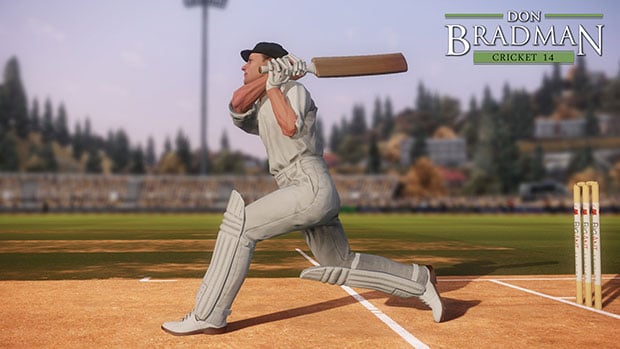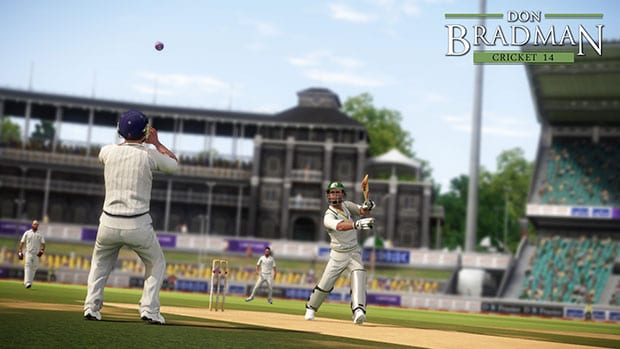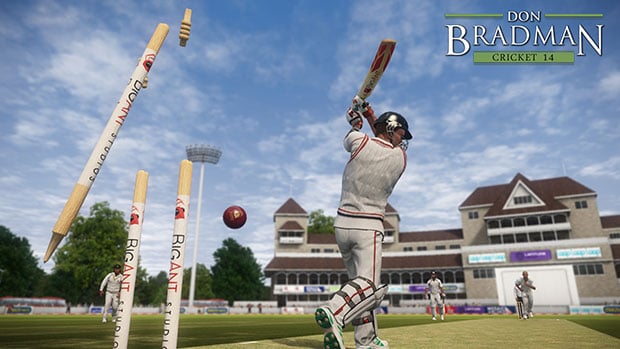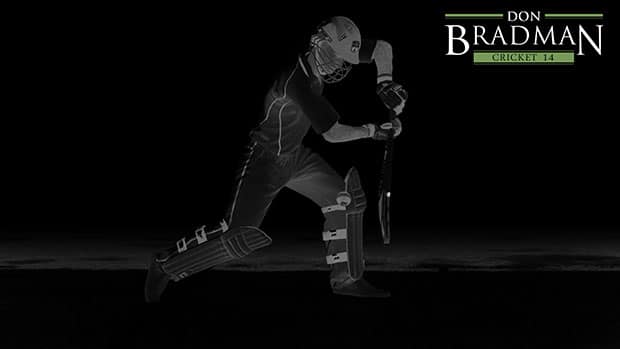These are tough times for the Indian cricket fan. The national team is going through one of its roughest patches in years; the upcoming general elections have cast a cloud over this year’s IPL season; the gamers among us had to deal with the disappointment of Ashes Cricket 2013; and, well, there’s always another match-fixing scandal around the corner. So this month’s release of Don Bradman Cricket 14 could be just the shot of escapism we so desperately seek. It helps, of course, that developer Big Ant Studios is promising the most comprehensive simulation of the gentleman’s game we’ve ever seen. Can they deliver on it though?

Customisation lies at the very core of the DBC14 experience and permeates every aspect of the game. If you’ve been mucking around with the Cricket Academy over the past year or so, that’s just the tip of the iceberg.
Publisher TruBlu was in India recently and I had the opportunity to check out the game at length, along with a bit of hands-on time, and one thing became clear immediately. Customisation lies at the very core of the DBC14 experience and permeates every aspect of the game. If you’ve been mucking around with the Cricket Academy over the past year or so, that’s just the tip of the iceberg. Every aspect of team formation, tournament structure, match rules, and time-of-day and pitch settings can be adjusted to your liking. Want to play a 30-overs-a-side match with 20 overs of powerplays and Test match wides? You can do that. How about making both teams play in Test whites for a match that begins at midnight and ends at 9 am and uses a pink ball? That’s possible too. Can a Delhi pitch generate bounce like it was Perth? In this game it can.
If I’m forgetting most of the game’s possible tweaks, it’s because there are just so many, and what this told me, above all else, was that this is a game made by a team that loves cricket. It’s a game designed to deliver unlimited replay value – something past cricket games have failed miserably at. But while customisation options will surely add longevity to the game, it’s the gameplay that carries a cricket game, and here again, there’s good news.
In past cricket games, you had a measure of the AI within hours of starting the game – the simplistic bowling patterns, the predictable batting routines – so single-player simply couldn’t hold your interest long enough. Not so in DBC14. For starters, there’s no hand-holding by way of pitch markers. Bowling and, to a greater extent, batting are about strategy, observation, reflexes and timing. There are no cookie-cutter deliveries. Subtle variations in pace, movement and bounce off the pitch mean that even if you think you’ve played the same shot as the previous delivery, the result will not be the same. There’s also no mini-map to show you where the fielders are placed. You’ll have to switch to first-person mode between deliveries to look around and scope out the gaps. While I appreciate this single-minded pursuit of realism, I thought this went a little too far though. It’s a little too tedious to look around the field two or three times per over, let alone before every single delivery, but I do appreciate the thought behind it.

Batting uses a twin stick system reminiscent of the Fight Night series…. It feels instantly organic and it makes me wonder why cricket games didn’t always play like this.
Gameplay is also drastically different than what we’ve been used to in cricket games. Batting uses a twin stick system reminiscent of the Fight Night series. One stick determines your foot placement, while the other is used for strokeplay. It feels instantly organic and it makes me wonder why cricket games didn’t always play like this. The same goes with bowling. You have to pull back on an analogue stick as your bowler approaches the bowling crease and the push it forward for him to deliver it. Spin bowling additionally requires you to rotate a stick to impart spin on the ball. It’s all a far cry from the simplistic button presses of past games. There’s a massive learning curve here and my miserable performances initially left me a little depressed, but then I watched the TruBlu representative – who isn’t a gamer – play the game having already spent hours with it, and it was easy to see that this is the sort of game you’ll get better at over time. For a cricket game, that’s an exciting prospect. Ball physics have a role to play here as well. I was strangely thrilled to see myself knick a ball after some terrible shot selection. Seeing the ball deviate off the edge and into the keeper’s gloves actually felt good because this was an aspect older games just didn’t get right.
Speaking of past games not getting things right, DBC14 doesn’t half-ass fielding either. The game allows you to select how much control you want over fielding. When an opponent plays the ball into the outfield, the game will automatically select the fielder best placed to chase it down. You can either manually have him chase the ball and throw it at either end, or you can have the AI chase it down, leaving you to only choose which end he returns it too. Or you can just not bother and have the AI do it all. My only concern with fielding is that the fielders tend to slide around way too much; often when it isn’t warranted. The diving animations are also rather long, so you’ll often see a fielder within the circle slide towards the ball almost immediately after the ball leaves the bat. Thankfully, these unnecessary slides don’t allow for the batsmen to take extra runs as in Codemasters’ old games.
It’s quite amazing to think that the career mode, which is a staple in pretty much every sports game out there, will be included for the first time in a cricket game in DBC14, and here again, it’s far from tacked on. The mode focuses on the career progression of one individual across 20 years as he moves from domestic cricket obscurity to the ultimate goal of becoming the national team Test captain. You start out by either creating a player from scratch in Cricket Academy or using a pre-existing one, followed by choosing his specialty. You can play either as a batsman, bowler, wicketkeeper-batsman, batting all-rounder or bowling all-rounder. You also get to pick the player’s position in the batting order, which is also important, because if you choose to play as a fast bowler, but have him at number 7 in the batting order, he won’t get as many opportunities as a number 11. That is remarkable attention to detail.

The career mode focuses on the progression of one individual across 20 years as he moves from domestic cricket obscurity to the ultimate goal of becoming the national team Test captain.
Regardless of your player’s nationality, he can start his domestic career in any country. For example, an Indian player could start out at an English County side. As you progress through your career, from domestic team, to national T20 team, to national ODI team, and then to the Test squad, there are various levels of progression within each squad. From a benchwarmer, to fringe player, to regular player, to core team member, the more squads you’re involved in and the more important your role becomes in each, the more XP you’ll earn to level up your player.
As for the matches themselves, you won’t always get picked early on in your career. Once you do get picked, you only get to play when your player is involved. You can either watch the rest of the match, simulate it, or if your team is in the field, you can stand in the outfield hoping the ball gets hit your way. You can also choose to simulate up to a certain point in the match – till your involvement, till the end of a session, till the fall of a wicket, or till a certain score milestone. I couldn’t even scratch the surface of the career mode in my limited time with the game, but the TruBlu representative I spoke with said he’d been playing the career about six hours a day for 18 days, and was still only 4-5 years into the 20-year career mode, which is massive.
The one aspect of the game that left me a little disappointed was the visuals. Now, this game obviously didn’t have the massive budgets of a FIFA or NBA 2K, so I wasn’t expecting that level of visual polish either, and I fully expected some jarring animations and/or a few texture issues, but while the game held up in those respects, the PS3 version I played on had quite obvious frame rate and screen tearing issues. This could’ve been unique to the debug version of the game I was playing, and it may well be rectified for launch, but it’s worth mentioning all the same. I should also mention that in terms of pure graphical crispness, the PS3 version was nowhere close to the batting nets demo that is available in the Cricket Academy – maybe a sign that the delayed PC version is the one to get. That said, replays in this game look phenomenal, so much so that you’ll want to slow them down, turn the camera around and just admire them from every angle.

A few visuals issues aside, it’s hard to not be impressed with Don Bradman Cricket 14 as a whole. There are so many little details here and there that I haven’t mentioned, which cricket fans will truly appreciate. Like the attention to detail in replicating DRS and the broadcast-style replays that precede it. Like the way a batsman’s stamina depletes if he tries slogging every ball or sprinting for each run. Like how you’re prompted to replace all the unlicensed teams and players with cherry-picked alternatives created by the community the first time you launch the game. Like how the commentators question your decision not to appeal for a possible LBW. Don Bradman Cricket 14 isn’t simply a cricket game for gamers, but for all cricket fans. If you’re either, you simply have to pick it up.
Don Bradman Cricket 14 is set for release in March on PS3 and Xbox 360, with a PC release to follow two months later.
Keep an eye on our Don Bradman Cricket 14 game page for all the latest on the game.



